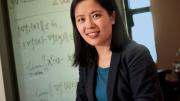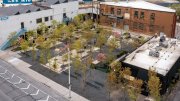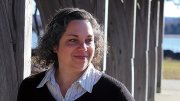As a pure-mathematics student at China’s Zhejiang University, Na Li often asked professors how her courses applied to real-life systems. If she stuck to her non-overlapping science and math classes, they said, she’d figure it out. Hoping to study mathematical biology at a UCLA summer research program before senior year, she was instead assigned to an engineering lab. “I was like, ‘What do you mean? I don’t know what mechanical engineering is, I don’t know what electrical engineering is.’” To prepare, she read Signals and Systems, a systems theory textbook that applied math to the study of complex entities. It clicked: this was the field for her. Li, now Cabot associate professor of electrical engineering and applied mathematics, deals mostly with the electric power grid in her research, transforming an outdated system to handle variable, alternative energy sources like wind and solar. Though some scoff at the possibility of a cascading power failure, Li, who experienced frequent power outages while growing up in rural China, does not: “I know the grid is not really reliable if you don’t have the right infrastructure and the right algorithms.” Her expertise expands beyond power systems. She remains fascinated with biology and physiology, and grabbed a copy of How the Immune System Works from her bookshelf to demonstrate the omnipresence of networks in the human body. “I still treat biology systems as a network. It’s just the network has different nodes and different interactions.” At home with her two young children, Li takes a break from systems and devours books on early childhood education. Even then, she can’t turn off her analytical approach: “It helps me think about why I have emotions. What is a rational way, what’s the irrational way, and how to control them….I have a lot of scientific theorems to explain what’s going on.”
An electrical engineer and applied mathematician, in brief
An electrical engineer and applied mathematician, in brief
For a star electrical engineering professor, it's all about systems.

Na Li
Photograph by Stu Rosner
You might also like
Landscape Architect Julie Bargmann Transforming Forgotten Urban Sites
Julie Bargmann and her D.I.R.T. Studio give new life to abandoned mines, car plants, and more.
Preserving the History of Jim Crow Era Safe Havens
Architectural historian Catherine Zipf is building a database of Green Book sites.
Harvard’s Michael Ansara on Activism and Resistance
A retrospective on resistance
Most popular
Explore More From Current Issue

Harvard In the News
A legal victory against Trump, hazing in the Harvard-Radcliffe Orchestra, and kicking off a Crimson football season with style

Concerts and Carols at the Isabella Stewart Gardner Museum
Tuning into one of Boston's best chamber music halls






